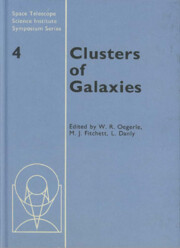Book contents
- Frontmatter
- Contents
- Preface
- Participants
- Chapter 1 Cosmology and Cluster Formation
- Chapter 2 Clusters of Galaxies: Structure, Infall, and Large-Scale Distribution
- Chapter 3 Cosmogony with Clusters of Galaxies
- Chapter 4 Cosmogony and the Structure of Rich Clusters of Galaxies
- Chapter 5 The Dark Matter Distribution in Clusters
- Chapter 6 The Effect of the Cluster Environment on Galaxies
- Chapter 7 Evidence for Gas Deficiency in Cluster Galaxies
- Chapter 8 Properties of Galaxies in Groups and Clusters
- Chapter 9 Dynamical Evolution of Clusters of Galaxies
- Chapter 10 Hot Gas in Clusters of Galaxies
- Chapter 11 Hydrodynamic Simulations of the Intracluster Medium
- Chapter 12 Evolution of Clusters in the Hierarchical Scenario
- Chapter 13 Distant Clusters as Cosmological Laboratories
- Chapter 14 Future Key Optical Observations of Galaxy Clusters
- Chapter 15 Cluster Research with X-ray Observations
- Plate section
Chapter 4 - Cosmogony and the Structure of Rich Clusters of Galaxies
Published online by Cambridge University Press: 06 July 2010
- Frontmatter
- Contents
- Preface
- Participants
- Chapter 1 Cosmology and Cluster Formation
- Chapter 2 Clusters of Galaxies: Structure, Infall, and Large-Scale Distribution
- Chapter 3 Cosmogony with Clusters of Galaxies
- Chapter 4 Cosmogony and the Structure of Rich Clusters of Galaxies
- Chapter 5 The Dark Matter Distribution in Clusters
- Chapter 6 The Effect of the Cluster Environment on Galaxies
- Chapter 7 Evidence for Gas Deficiency in Cluster Galaxies
- Chapter 8 Properties of Galaxies in Groups and Clusters
- Chapter 9 Dynamical Evolution of Clusters of Galaxies
- Chapter 10 Hot Gas in Clusters of Galaxies
- Chapter 11 Hydrodynamic Simulations of the Intracluster Medium
- Chapter 12 Evolution of Clusters in the Hierarchical Scenario
- Chapter 13 Distant Clusters as Cosmological Laboratories
- Chapter 14 Future Key Optical Observations of Galaxy Clusters
- Chapter 15 Cluster Research with X-ray Observations
- Plate section
Summary
Abstract. N-body simulations of the formation of clusters of galaxies allow a detailed, quantitative comparison of theory with observations, from which one can begin to address two fundamental and related questions:
Can the observed properties of rich clusters of galaxies tell us something about the cosmological initial conditions?
Can we use N-body simulations of clusters to test/constrain theories for the formation of the large-scale structure of the universe?
INTRODUCTION
A wide range of theories have been proposed to explain the origin of galaxies, clusters of galaxies, and the large-scale structure of the universe. Broadly speaking, these can be divided into two classes. Most currently popular models for the formation of structure in the universe are based on the idea of gravitational instability in an expanding universe, in which it is assumed that structure has grown gravitationally from small-amplitude, Gaussian primordial density fluctuations. A second class of cosmogonic scenarios, which will be referred to here as non-Gaussian models, appeal to other processes besides simple gravitational clustering as the driving force behind the genesis of structure.
Within the basic framework of the gravitational instability picture, there are several rival theoretical scenarios that are viable at present. Depending on the the details of the cosmological initial conditions and dominant mass component of the universe, the sequence of formation of structure may have proceeded in quite different ways. If, for instance, the universe is dominated by weakly interacting, non-baryonic particles (i.e., cold dark matter, hereafter CDM) then the formation of structure is expected to proceed hierarchically from small to large scales, with galaxy and cluster formation preceding the collapse of superclusters.
- Type
- Chapter
- Information
- Clusters of Galaxies , pp. 65 - 110Publisher: Cambridge University PressPrint publication year: 1990
- 2
- Cited by



